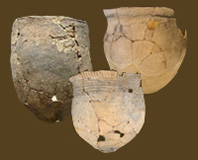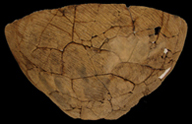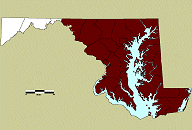Accokeek
Defining Attributes
Accokeek is an Early Woodland ware that is
sand-tempered or crushed quartz-tempered with cord-marked exterior
surfaces. This pottery is often identifiable by the pronounced
oblique cord-marking, slanting to the right from the vessel rim.
Chronology
Stratigraphic sequences and radiometric dating indicate
that Accokeek dates from ca. 900 B.C. – 300 B.C.
Distribution
Accokeek pottery is found throughout the Coastal Plain of
Maryland and into Virginia to the James River. On the Western
Shore of Maryland, Accokeek’s core distribution extends into the
Piedmont beyond the headwaters of the Patuxent River and into
the Patapsco drainage. It is also found up the Potomac River valley
to the Monocacy drainage. Accokeek ceramics have been recorded
on sites throughout the lower Eastern Shore in both Maryland and
Delaware from Dover south.
Description
Paste/Temper
The paste has a sandy texture, ranging from coarse and soft to
medium fine and hard, and is usually friable. Composed of fine-grained,
moderately compact clay, Accokeek pottery is often reddish due
to the clay’s ferruginous content. The temper consists of coarse
to medium fine sand or crushed quartz that comprises 20% – 50%
of the paste. Small amounts of angular quartzite, mica,
and gneiss are sometimes added. Accokeek pottery as defined in
the Potomac River drainage is tempered with medium to coarse
sand and has a very sandy, gritty texture. In the Patuxent drainage,
crushed quartz temper predominates and the pottery feels less
sandy. The Moh’s hardness for Accokeek sherds ranges between
2.0 and 3.0. Color varies from an oxidized dull black through
brown, red, orange, and gray
to tan and buff, with reddish tans or gray browns generally the
norm.
Surface Treatment
Exterior surfaces are roughened with cord-wrapped paddle impressions
made in a wet clay. The cord-markings are nearly always oriented
diagonally downward to the right from the rim, but horizontal
and vertical impressions have been observed. The cordmarking is
thick and commonly spaced 1 mm – 8 mm apart. Sometimes when the
cordage is loosely wrapped around the paddle resulting in an overstamped
appearance. Cord-marking commonly extends from the lip to the
base. Smoothed rims and unmarked bases, however, have been found.
Interior surfaces are smoothed. Some sherds have uneven interior
surfaces that suggests the use of the hand as an anvil in conjunction
with a paddle during manufacture.
Decoration
Accokeek pottery is usually undecorated. Occasionally, some sherds
have smoothed-over cord marking from the base to the lip, and
cord impressions on or just below the lip. Rarely, incised decorations
have been observed on Accokeek pottery. At the Accokeek Creek
site, 18PR8, about 5% of the rim sherds were decorated with incising
that included long triangles, horizontal zig-zag lines, vertical
or horizontal straight lines, crossed lines, or short random lines.
These incised pattern appear to have been made with a round-pointed
tool. A few sherds were decorated with rows of punctations.
Morphology
Accokeek vessels are coil constructed with paddle malleation.
Vessels shapes are conical, semiconical, or occasionally globular
with open mouths. The upper portions are cylindrical from the
rim to the midpoint, or expand slightly outward from the rim.
Rims are vertical or slightly everted, generally blending into
the body 5 cm – 10 cm below the lip. Flattened or rounded rims
have also been observed. Lips vary from straight and rounded,
to flattened or slightly everted. Bits of clay overlapping the
exterior and cord marks along the top are also common.
Bases are conical, semiconical, or occasionally round in shape,
and range between 9 mm to 21 mm thick. Some basal sherds seem
to have been modeled by hand from lumps of clay, with coil construction
beginning 4 cm – 10 cm above the basal point.
Vessel wall thicknesses decrease from the base up to rim. Sherd
thicknesses range from 6 mm – 8 mm. Vessel sizes range from medium
to large, with diameters ranging from 25 cm – 65 cm and vessel
height ranging from 25 cm – 40 cm. Coil widths range between 8
mm and 12 mm and coil breaks are common.
Defined in the Literature
Robert Stephenson originally defined Accokeek Cord Marked from
pottery excavated by Alice and Henry Ferguson from Accokeek Creek
site, 18PR8, on the floodplain of the Potomac River in Prince
George’s County, Maryland (Stephenson and Ferguson 1963). Evans
(1955) had defined a sand and quartz tempered ceramic from the
Virginia Piedmont that he called Stony Creek, a seldom used designation
today. Egloff and Potter (1982:99) believe that sherds found in
southeastern Virginia are remarkably similar to Accokeek, but
were fabric-, cord- and net-impressed. They suggest that cord-
and net-impressed sherds found north of the James River should
be referred to as Accokeek or Popes Creek Wares, but south of
the James River as Stony Creek. Dan Mouer (1991) links Accokeek
to Virginia’s Elk Island ceramics.
Type Site
Accokeek Creek (18PR8)
| Radiocarbon Dates |
| Date |
Sample # |
Site |
Feature |
Reference |
1870 + 125;
A.D. 80 |
M-1605 |
Martins Pond 2 (18AN141) |
Zone 2 |
Wright 1973:29 |
1840 + 80;
A.D. 110 |
Beta-48974 |
Patuxent Point (18CV271) |
|
|
References:
Egloff and Potter
1982; Mouer
1991; Stephenson
and Ferguson 1963 |






